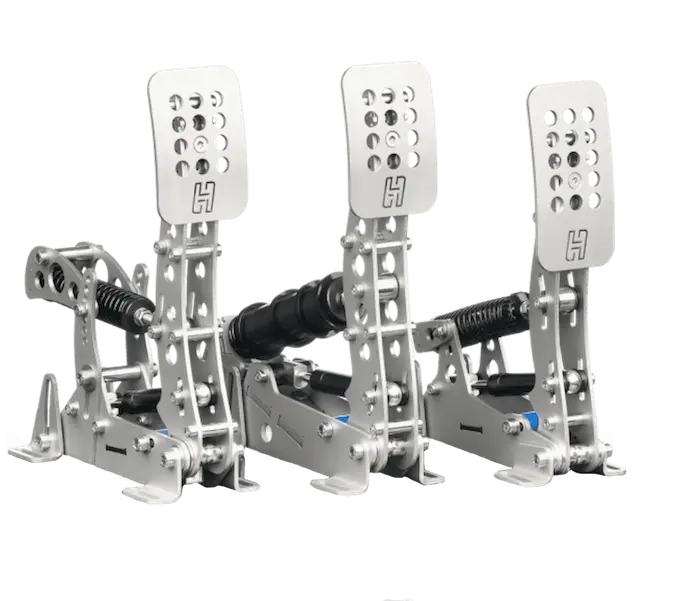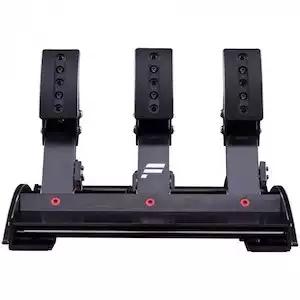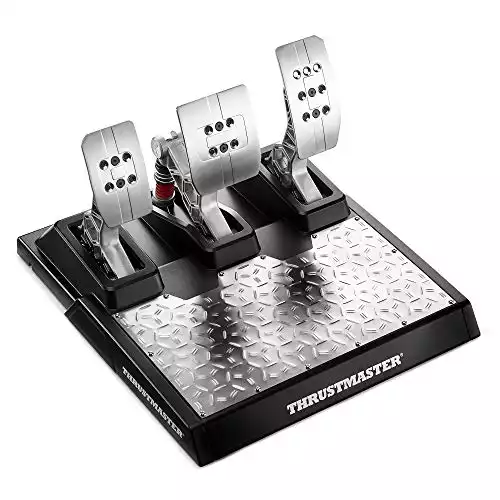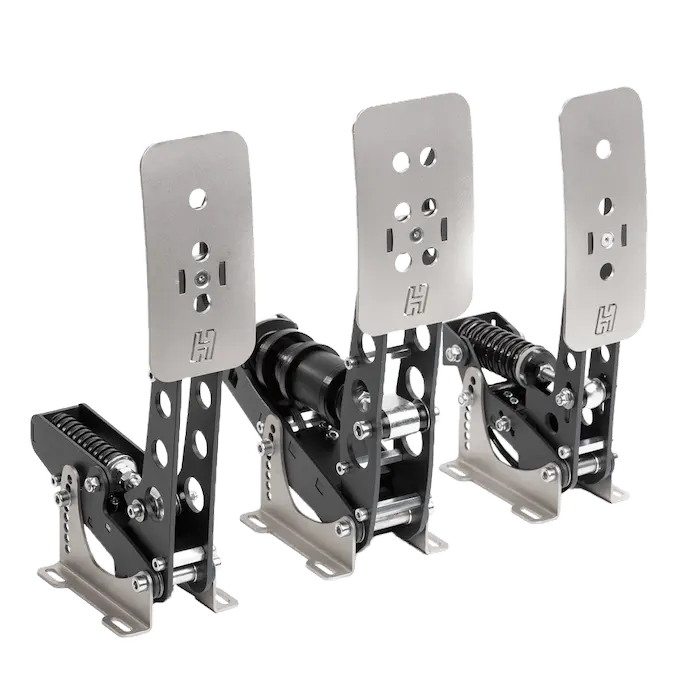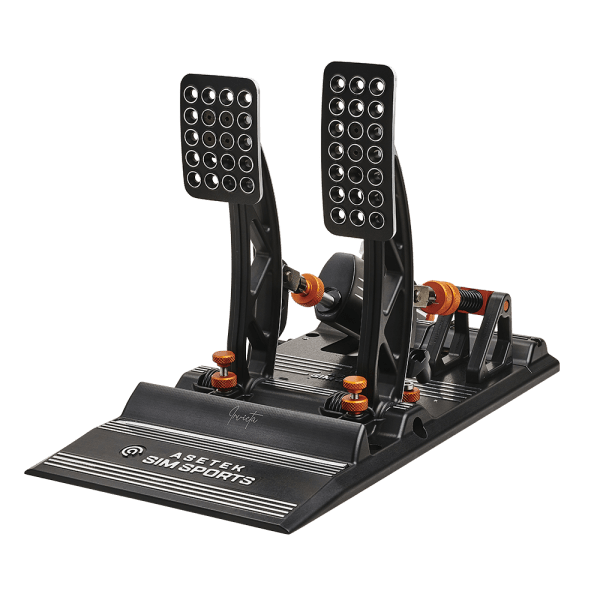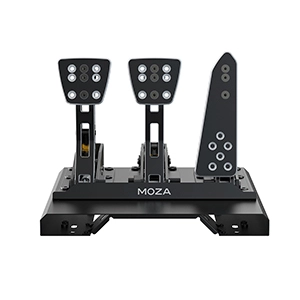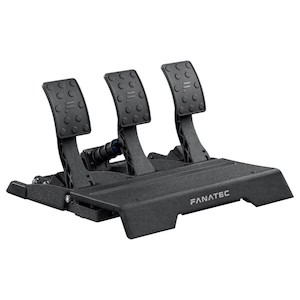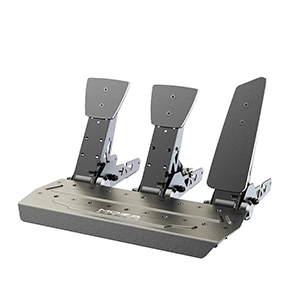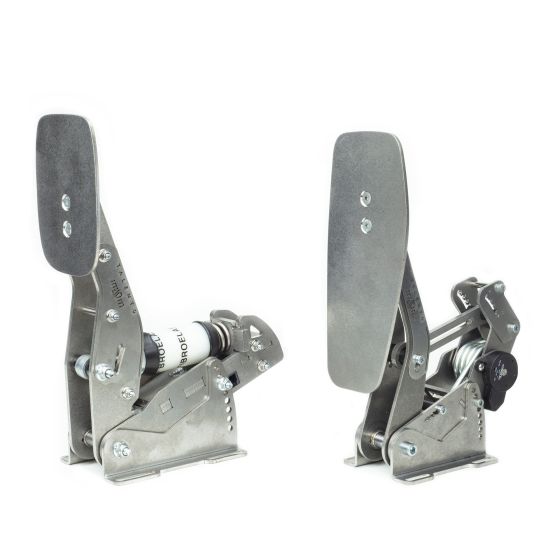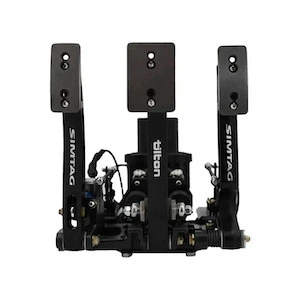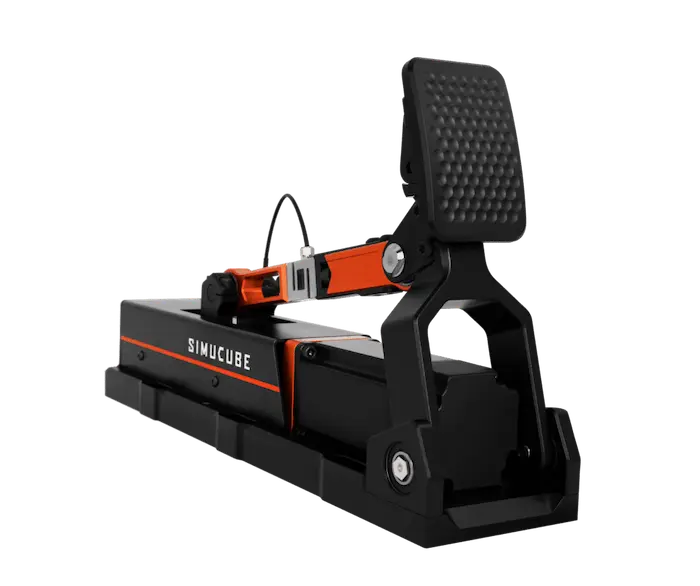Choosing the right set of sim racing pedals for your rig can be tough, as there are so many brands and options to choose from. However, once you know what to look for, it’s much easier to pick the best sim racing pedal set for your specific situation and experience level.
The best sim racing pedal sets are:
- Heusinkveld Ultimate+ Pedals
- Fanatec Clubsport V3 Pedals
- Simtrecs ProPedal GT
- Heusinkveld Sprint Pedals
- Simworx Pro GT V3.1 Pedals
- Asetek Invicta Pedals
- MOZA CRP Pedals
- Fanatec CSL Elite V2 Pedals
- Logitech Pro Pedals
- Thrustmaster T-LCM Pedals
- MOZA SR-P Pedals
- Simagic P2000 Pedals
- Meca Evo1 Pedals
- ImSim Talento Pedals
- Venym Atrax Pedals
- Simtag Hydraulic Pedals
- Simucube Active Pedals
Below, I’ll walk you through each of these pedal sets, explaining their pros and cons, and telling you who they’re best suited for. I’ll also include a summary table after the list if you want to quickly compare each of the options. After that, I’ll tell you everything you need to know about choosing sim racing pedals!
- • Incredibly immersive feel
- • Lots of adjustability
- • Outstanding build quality
- • Great for console racers
- • Built from high-quality materials
- • Built-in vibration motors
- • Very beginner friendly
- • Plenty of customization on offer
- • Good value for money
Note: There are a lot of sim racing pedals out there, with more appearing on the market all the time. Everybody wants different things from pedals and is at a different stage of their sim racing career. So, we’ve tried to make our list as comprehensive as possible, and it’s not ordered in terms of price or experience level.
However, we have included options for absolute beginners all the way up to the professional level and for all budgets. Under each pedal’s title, you’ll be able to see a rough experience level the pedals are aimed at, and their rough price point. We haven’t included numbers as they fluctuate all the time (and it will depend on whether you opt for 1, 2 or 3 pedals), but use the following as a guide:
• Low = $100 – $300
• Medium = $300 – $600
• High = $600 – $800
• Very High = $800+
This is a list of the best sim racing pedals, so there aren’t going to be any of the cheapest options, like those that come in bundles. But if you want to up your sim racing game, there will be a set of pedals on this list for you!
The Best Sim Racing Pedal Sets
Heusinkveld Ultimate+ Pedals
Experience Level: Advanced/Pro | Price Point: Very High
Who Should Buy These: Competitive sim racers and those at the top of their game (with a big budget)
Our list begins with one of the most renowned manufacturers in the sim racing space. Heusinkveld’s Ultimate+ pedals are trusted by professional racers and amateurs alike, and they provide some of the highest levels of immersion possible. While they are not aimed at beginners, they are worth checking out for anyone that is looking for the ultimate (pun intended) racing experience.
Heusinkveld Ultimate+ Pedals
Incredible Build Quality
What sets these pedals apart from many other options on the market is their solid build quality. They’re made from precision laser cut steel, and this means they offer a durable construction with zero flex. Not only do they offer reliability over time, but they also look amazing too!
The functionality of these pedals is also ahead of most of the competition, thanks to the triple load cell setup paired with hydraulic damping. Starting with the load cells, you get one on each pedal. While definitely not necessary, we’re not complaining about some additional accuracy on the gas and clutch pedals.
Great Adjustability
They’re custom-built load cells, and they offer 12-bit resolution for a responsive experience on every pedal. The brake pedal features a 200 kg load cell capable of handling up to 140 kg of force – more than enough for most people. You can adjust the feel of the brake pedal using the various injection molded elastomers.
This allows you to customize your racing experience very easily to replicate any kind of braking feel you can imagine. The hydraulic dampers on each pedal add a new layer of immersion, helping to simulate the finer details of braking that you would feel in a real car. They’re also present on the throttle and clutch pedals too, offering resistance at the ingoing and outgoing stroke of the pedal.
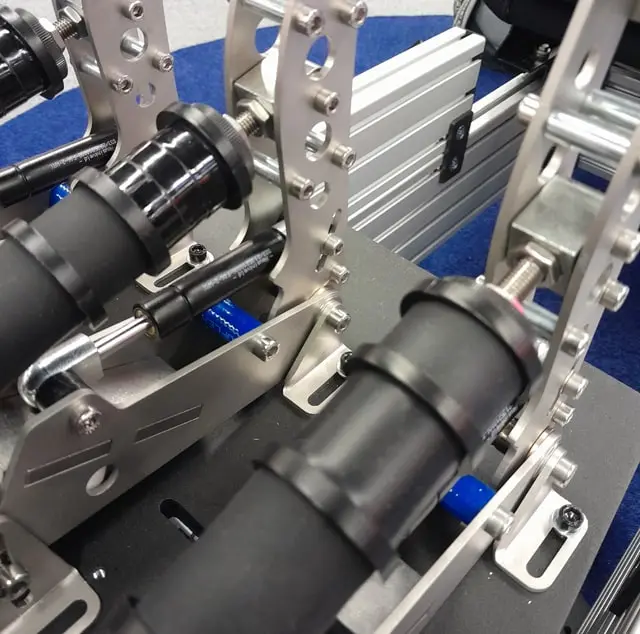
(also illustrating the various elastomer combinations)
No Maintenance Required
Because these pedals aren’t fully hydraulic – as the hydraulic dampers don’t interact with the sensors in any way – they don’t require any additional maintenance that some hydraulic sets do. This makes them easier to use and somewhat beginner friendly, although again I must note that these pedals are not aimed at the beginner market (and they’re expensive too).
Aside from the hardware, you also get access to Heusinkveld’s Smart Control software for making even more adjustments to how the pedals feel to use. You can save your settings to various profiles, making for a very customizable and easy to use experience.
Overall, these pedals are the ideal choice for sim racers at the top of their game, and for those that want to race competitively. They’re not cheap, and beginners likely wouldn’t be able to get the most out of them anyway, and so the Heusinkveld Sprint pedals would be a better choice. But the Ultimate+ pedals are still some of the best around!
Heusinkveld Ultimate+ Pedals
Key Specs:
- Compatibility: PC
- Mechanism: Load cells on all 3 pedals + hydraulic dampers
- Weight: 7 kg / 15.4 lbs
- Custom Software: SmartControl
PROS:
- Incredible build quality
- Hydraulic damping for excellent feel
- Very adjustable hardware and software
CONS:
- Very expensive
- Caters to a more competitive/advanced market
Fanatec ClubSport V3 Pedals
Experience Level: Intermediate | Price Point: Medium
Who Should Buy These: Sim racers with some experience and a reasonable budget (especially those on console) looking for an upgrade over their first/second set
Now it’s time to discuss the best set of pedals for console racers, the Fanatec ClubSport V3 Pedals. Among the sim racing manufacturers out there, Fanatec offers some of the best product innovation and build quality out there, and these pedals are no exception to that rule.
Fanatec Clubsport V3 Pedals
These are the best pedals for console players, and they offer some incredible immersion. The load cell brake offers a realistic racing feel, and the vibration motors just add to the amazing experience.
Excellent Build Quality
They come in sleek, CNC-machined black aluminum, which makes the pedal set the right mixture of sturdy and lightweight. The base is weighted and can be mounted with compatible wheel stands or cockpits, or it will sit without moving on hardwood or carpeted floors. However, I always recommend you hard mount your pedals for the best experience.
The accelerator and clutch come equipped with magnetic and contactless sensors for both a long life and maximum performance (although some users have reported sensor issues after years of heavy use). You’ll also find a load cell on the brake, which can take up to 90 kg of braking pressure.
Note: There is also an inverted set of these pedals for those that prefer this aesthetic and level of immersion
Tool-Free Adjustments
Perhaps the biggest benefit of all is the fact that you can adjust the brake without tools! You can achieve this by going into the Fanatec tuning menu, accessible through a Fanatec wheel or by plugging them into a PC, and you can tweak the preload easily with the built-in screw.
You can also make physical adjustments to all the pedals so that they can be reached comfortably, and you can even swap out the current pedals faces for different styles as you see fit.
Vibration Functionality
What I find very compelling about these pedals are the vibration motors on the accelerator and brake pedals. For the accelerator, the motor will vibrate to indicate wheelspin, and the motor on the brake will replicate ABS and tire lockups.
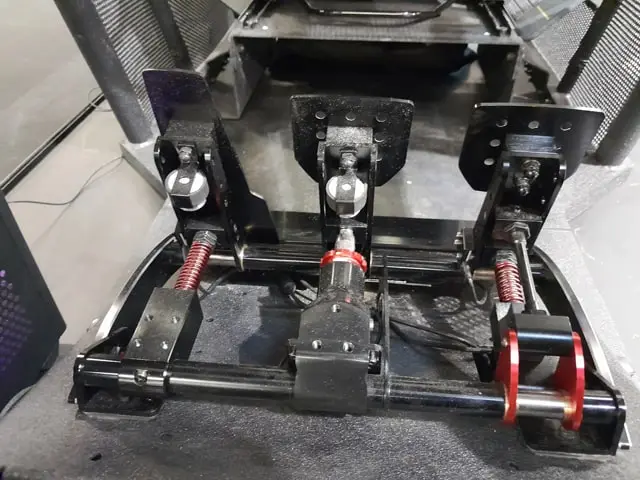
The ClubSport V3 pedals are compatible with PC and consoles, and thanks to Fanatec’s future-proof engineering, they won’t be going out of date any time soon! By updating the firmware, you can guarantee that the pedals will keep functioning with all new racing games that release for all systems.
Easy To Set Up
They also boast a very easy set-up, with plug-and-play available with all Fanatec wheels that are compatible with each respective system. You need to ensure that you have a wheelbase and racing wheel that will support the pedals if you’re on console, but PC users can obviously mix and match.
With these pedals, you’ll be buying an advanced addition for your sim racing rig that will enhance your driving and overall experience with its various realistic features and exceptional build quality. They’re a great balance of quality and cost, and their console compatibility sets them apart from many others at a similar price point.
Fanatec Clubsport V3 Pedals
Key Specs:
- Compatibility: PC / PlayStation / Xbox
- Mechanism: Load cell brake
- Weight: 7.9 kg / 17.4 lbs
- Custom Software: FanaLab
PROS:
- Compatible with PlayStation & Xbox
- Great load cell brake
- Additional immersive vibration functionality
CONS:
- Some sensor issues after many years of heavy use
Simtrecs ProPedal GT
Experience Level: Advanced/Pro | Price Point: Very High
Who Should Buy These: Pro and competitive drivers looking for a very advanced set of pedals
Up next we have a pedal set that offers an incredible amount of adjustability and an overall construction that is up there with the very best. The ProPedal GT set from Simtrecs is one of the sleekest looking products on the sim racing market, and they have performance levels to go along with that slick look.
Immense Adjustability
We’ll start with the adjustability of these pedals, as there are a lot of options at your disposal! First let’s consider the software, which is Simtrecs’ SmartDrive software, allowing you to fully customize all aspects of how your pedals behave. You can create custom profiles and curves for each pedal to tweak your deadzones and braking force to your liking.
You can choose between linear, exponential, one point and multi-point pedal characteristics, which is beyond what most beginners and even experienced sim racers will need. However, for those that want the ultimate level of control over every aspect of pedal behavior, this is a truly excellent feature.
Physical Adjustments
When it comes to making physical adjustments, it’s very easy with these pedals. You can tweak the distances between each pedal, the positions of the pedal facings on the brake and the clutch, and also the heights of these two pedals as well. You can also tweak the pedal angles of the throttle, brake and clutch.
Note: While you can’t tweak much of the throttle pedal’s physical setup as the pedal’s face is attached directly to the pedal arm, the large pedal design means it will likely suit most driving styles anyway.
Each pedal also features hydraulic damping (like the Heusinkveld Ultimate+ pedals), and this helps to offer a very smooth pedal feel for easier modulation. The brake pedal’s damper features a resistance adjuster screw, allowing you to tweak the feel as precisely as you could ever need!
You can also swap out nuts and washers to change the preload behavior of the brake, and you can sub in lots of different elastomers to tweak the feel even further. There is plenty of adjustment on the clutch pedal too for those that need it, and it naturally feels firmer at the start of the pedal travel, before getting softer at the end, simulating a real clutch’s feel.
Build Quality
These pedals are exceptionally well made, with CNC machined billet aluminum making up the bulk of the pedal design. There is no wobble or flex with the Simtrecs ProPedal GT set, and the build quality continues in the electronics within the pedals themselves, including the use of Vishay potentiometers, which outperform (by a long way) standard potentiometers found on cheap pedal sets.
These are an expensive choice, and they’re aimed at those looking for premium sim racing pedals that offer a huge range of customization options. The video above shows these pedals in action, and you’ll see why we find them so impressive!
Key Specs:
- Compatibility: PC
- Mechanism: Load cell brake + hydraulic damping
- Weight: 7.2 kg / 15.9 lbs
- Custom Software: SmartDrive
PROS:
- Unbelievable build quality
- A huge range of adjustability
- Very immersive feel
CONS:
- An expensive choice
- Can be hard to find
Heusinkveld Sprint Pedals
Experience Level: Intermediate/Advanced | Price Point: High
Who Should Buy These: Those looking for an alternative to the Fanatec V3s, or those upgrading from their first or second pedal set
For many years, Heusinkveld has been purpose-building pedal sets and other high-quality sim racing gear specifically made for excellence, especially since real race drivers the world over use their products to stay at the top of their game. This set of pedals is designed for esports professionals and casual racers alike, offering consistency and realism in equal measure.
Heusinkveld Sprint Pedals
These pedals are some of the most advanced on the market. They are built to last, and offer some amazing adjustability that allows for a fully immersive and customizable sim racing experience.
Build Quality
This pedal set is made with absolute precision, composed of laser-cut steel for both lightweight responsiveness and that coveted sturdy feel. The manufacturer went above and beyond normal testing procedures and used complex mathematical models to calculate how the pedals would travel and with how much force. This leads to a very accurate set of pedals at your feet.
Loads cells can be found on all three pedals, which is a very premium feature indeed at this price point. While there are no hydraulic dampers like we saw on the Ultimate+ pedals from Heusinkveld, they still provide excellent feel and this significantly reduces the price too.
Lots Of Adjustability
You can adjust each pedal’s physical position, and you can also program each pedal’s resistance and loads of other variables on your PC. Being able to configure deadzones and output curves to suit your needs allows for lots of customization over your sim racing experience.
But don’t let that put you off, casual PC sim racers! The pedals are also user-friendly, and you can start using them straight away. It’s just nice to have all of those customization options available, especially when you start to get competitive.
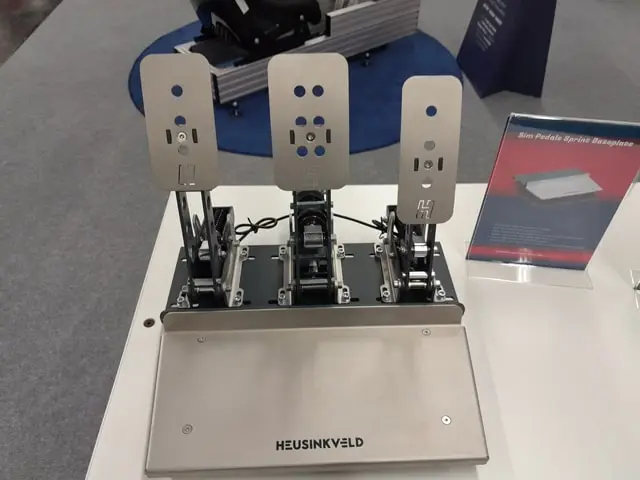
Reliable & Durable
If you buy these pedals, you’ll be buying a set that will last and evolve with the rest of your sim racing rig. And as you progress as a racer, you can accurately adjust this pedal set for continued improvement. Just note that you’ll need to pick up a pedal baseplate separately (as is common with high end pedal sets).
The limiting factor is, of course, the lack of compatibility with consoles. This is due to the high processing power required to run these pedals, along with licensing hoops manufacturers need to jump through to make them compatible with PlayStation and Xbox. But if you own a PC, the Sprint pedals are an excellent choice!
Heusinkveld Sprint Pedals
Key Specs:
- Compatibility: PC
- Mechanism: Load cells on all 3 pedals
- Weight: 4 kg / 8.8 lbs
- Custom Software: SmartControl
PROS:
- Very reliable pedals
- Ability to be customized to precise levels
- Superior build quality
CONS:
- Only compatible with PC
- A fair bit more expensive than the Fanatec V3s
Simworx Pro GT V3.1 Pedals
Experience Level: Advanced/Pro | Price Point: Very High
Who Should Buy These: Competitive and pro sim racers that need durability and adjustability above all else
Next up we have the Pro GT V3.1 pedals from Simworx. These pedals are quite pricey, but I believe that the realism they offer, paired with their high level of adjustability, makes them one of the best sets of pedals for the intermediate racer through to the advanced racer too.
Note: These really are aimed at competitive and professional racers, and their price tag matches that. So if you’re in the market for a more beginner friendly set, check out something like the T-LCMs or MOZA’s SR-P pedals.
A Lot Of Braking Force
The maximum potential braking force on these pedals is massive, at more than 140 kg (300 lbs). This is more than the average sim racer needs, but it offers plenty for the most advanced racers to get the most out of them. The pedals themselves were designed in part with the help of some real race car drivers, and this ensures that they are as close to the real thing as possible.
Top-Quality Construction
The build quality of these pedals is excellent, as a CNC machine has been used for the ultimate precision. This means that not only do the pedals look great, but they also feel great and offer extensive longevity as well. The all-metal construction means that the pedals look like they have come straight out of a race car, and they behave like that too.
In terms of adjustability, the Simworx load cell pedals offer plenty. There are adjustable dampers that you can play around with, making it very easy to find the exact feel that you are looking for. Not only are the mechanics of the pedals fully adjustable, but their positions are as well. All three pedals can be moved around in six different ways.
The All-Round Best Choice
This allows for tuning to your specific desires, and so you can set them up for maximum comfort. This set of sim racing pedals is easy to set up, and they look and perform great too. Although a bit more expensive than some other options, I believe they are one of the best options if you’re looking for something truly competitive.
Key Specs:
- Compatibility: PC
- Mechanism: Load cell brake with hydraulic damping
- Weight: N/A
- Custom Software: N/A
PROS:
- Excellent construction
- Top-quality performance
- Fully adjustable
CONS:
- Quite expensive
- Hard to get
- More than most will need
Asetek Invicta Pedals
Experience Level: Intermediate/Advanced | Price Point: High
Who Should Buy These: Fairly experienced sim racers that prefer a hard brake pedal (and want to experience hydraulics)
Up next we have the Invicta pedals from Asetek, and these are another great looking set of pedals with performance chops to boot. They’re a mid range pedal set, but they perform like some of the more expensive options too. They feature a brilliant hydraulic brake, and this makes them ideal for advanced racers that put a focus on immersion.
Asetek Invicta Pedals
Great Looking Pedals
It’s worth noting right off the bat that these pedals look great. The exact color scheme might not be to everyone’s tastes, but there’s no doubt that they stand out from the others that go for a plain and simple machined aluminum look. These pedals are still made from CNC machined parts, but Asetek went the extra mile in making these pedals a true work of sim racing art!
But the real selling point of the Asetek Invictas is their hydraulic brake. Well, to be more specific, the T.H.O.R.P. system that Asetek came up with that utilizes Twin Hydraulic Opposing Rapid Pistons. Essentially, this makes for a very realistic feeling brake pedal that allows you to really dial in your muscle memory for maximum consistency.
You can adjust the feel further by swapping out the elastomer inside the brake component, and this will affect the level of play you get in the pedal before the hydraulics kick in. This is responsible for the ‘dual stage’ braking in these pedals, and whether or not this suits your racing style will really come down to personal preference.
Note: The brake pedal on the Invictas is very stiff. This will take some getting used to, and it may not suit every sim racer, but it can allow you to really dial in your muscle memory over time.
Adjustability
You’ll see a lot of different knobs and dials on these pedals that you can use to adjust various aspects of them, with the accelerator and clutch for example featuring a dial that allows you to adjust the end stop of the pedals. This tweaks how far the pedal itself can travel.
You can also adjust the feel of the throttle by swapping out the standard spring, and you can change the pedal angles as well. You can also adjust the pedal facings too, so you can position them to suit your racing style.
Note: There are two versions available, and the ‘S’ version is the one to go for if you want to be able to adjust the spacing between the gas and clutch pedals. You might also want to pick up their separate pedal facings if you race in socks, as the standard metal facings are a little rough!
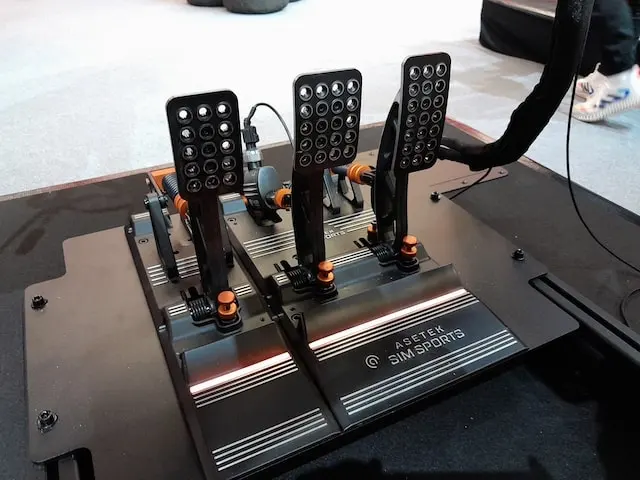
Other Points To Note
If you use a shifter, you’ll be able to benefit from the clutch pedal’s bite point feel (the clutch is sold separately). You can adjust the physical bite point of the pedal with what you feel in-game, and this is really useful for getting the perfect launch in games that rely on manual transmission use.
Overall, these pedals go above and beyond what many sim racers will ever need, but they do offer some of the most immersive feel that you’ll find. They’re not the most expensive options out there either, so they’re definitely worth checking out if you’re looking for a hydraulic brake.
Key Specs:
- Compatibility: PC
- Mechanism: Hydraulic brake (T.H.O.R.P.)
- Weight: 3 kg / 6.6 lbs
- Custom Software: RaceHub
PROS:
- Incredibly immersive brake
- Excellent build quality
- Designed to emulate a real race car’s pedals
CONS:
- Brake pedal feel may not be for everyone
MOZA CRP Pedals
Experience Level: Intermediate | Price Point: Medium
Who Should Buy These: Those looking for a very well made, adjustable set of pedals in a similar category to the Fanatec V3s and Heusinkveld Sprints
Up next we have a Fanatec competitor in the brand MOZA, and their CRP pedals are currently the best they have to offer. These advanced load cell pedals are truly impressive, but they are a bit more expensive than Fanatec’s ClubSport offering. However, they are still a very good choice for those looking to take their sim racing up a level.
MOZA CRP Pedals
Pure Immersion
These pedals offer some incredible immersion, in large part thanks to the high-quality load cell sensor in the brake pedal. This provides realistic braking feel, and of course it’s highly adjustable via springs and damper blocks, and you can tweak things further using MOZA’s Pit House app right from your phone.
The brake pedal is what most sim racers will be looking at when comparing pedal sets of course, but another unique feature of these pedals that adds to the immersion is the 3-stage clutch. This offers three levels of resistance to better emulate how it feels to press a real clutch pedal, and this can also help you nail those launches at the start of races too.
Note: Obviously this won’t be much of a selling point if you don’t race manual cars, but it’s worth considering if you plan to upgrade your rig with a shifter in the future.
Excellent Design
The overall look of the pedals is striking, with the black and gold color scheme sure to add a premium aesthetic to your rig. The long, organ-style throttle pedal is certainly eye-catching, but it can also allow for more consistency and comfort if that’s the style of pedal you prefer.
You can easily adjust the travel of each pedal, and you can change their positions too, for easy optimization of your sim racing setup. You can tweak the angles of the pedals as well, and their CNC aluminum design makes them look, feel, and perform at a premium level.
High-Quality Kit
The load cell is a 100 kg sensor, which is more than enough for most people’s braking needs. It’s designed for consistency and precision, and it helps make this pedal set one of the best on the market. However, another reason these are marked lower than the similarly priced ClubSports is that they are not compatible with console, which is a shame for those on PlayStation or Xbox.
However, if you’re on PC and are looking for a premium load cell pedal set, this is definitely one to consider. MOZA are also constantly expanding and improving their ecosystem of products – these pedals in particular have been updated several times using feedback from real sim racers.
MOZA CRP Pedals
Check PriceKey Specs:
- Compatibility: PC
- Mechanism: Load cell brake
- Weight: 7.5 kg / 16.5 lbs
- Custom Software: Pit House App
PROS:
- Excellent build quality
- Immersive load cell brake
- 3-stage clutch
CONS:
- Quite expensive
- Only compatible with PC
Fanatec CSL Elite V2 Pedals
Experience Level: Beginner | Price Point: Low
Who Should Buy These: Beginners and those on console looking for their first set of load cell pedals
The CSL Elite V2 set is part of Fanatec’s CSL Elite line of sim racing products, described to be best for entry-level racers without compromising on quality. If you’ve got a Fanatec wheel and base but can’t stretch to the ClubSport set, these pedals will definitely be the ones for you.
Fanatec CSL Elite V2 Pedals
These pedals are fairly beginner friendly without compromising on quality and features. They look great and will fit into any rig, and their load cell brake provides an excellent immersive feel.
Durable Pedals
The whole set of these matte black pedals is made of metal and then coated with a matte metal powder, guaranteeing long life. They also come with detachable rubber pedal sleeves that you can easily put on or take off, giving you more control over the specific feel of the pedal facings themselves.
The pedal set’s base is weighty and has anti-slip pads underneath, meaning that if you don’t mount it into a wheel stand or cockpit, they still won’t be going anywhere under hard braking (although I always recommend hard mounting your pedals if possible). Its brake has a load cell installed, and this means you can apply up to 90 kg (200 lbs) of force to the pedal.
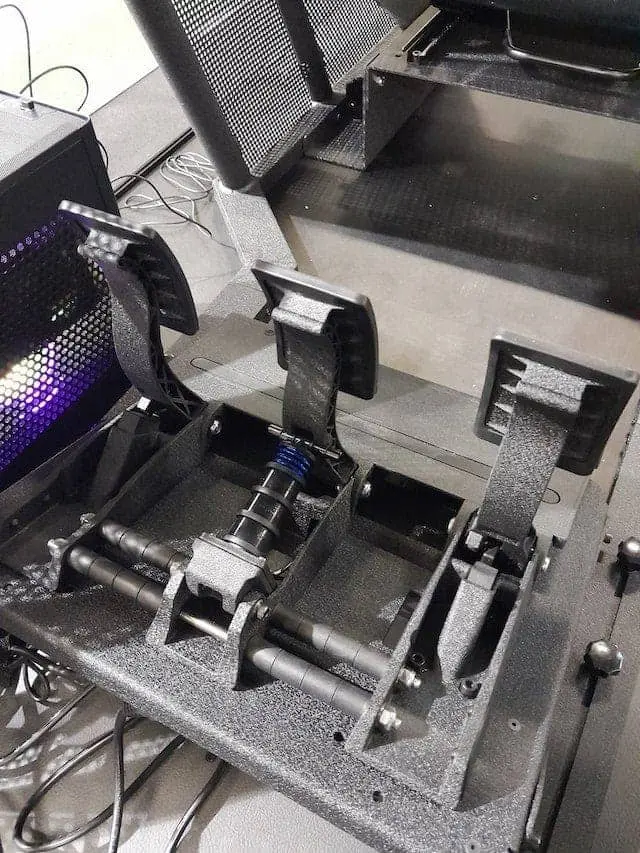
Each pedal in the set can be individually adjusted in both height and spacing to make driving as comfortable as possible. You also have the option to use the Fanatec tuning menu to adjust your brake settings, or tweak it physically with the elastomers at the back of it.
More Flexibility
If you already have an installed pedal mount and can’t have a free-standing base, don’t worry! You can remove all of the pedals from their base and mount them separately into your cockpit.
The pedals are a pretty nice mixture of technical and simplistic, with the ability to be used easily by casual racers and more experienced racers alike. For their price, you’ll be getting a set of pedals that will last for a long time and grow with you, thanks to the adjustable brake pedal.
They do fall short compared to the ClubSport V3 pedals of course, because they lack vibration motors that add an extra bit of immersion to your rig and they’re not the most adjustable. But they’re still a solid set, especially if you’re looking for something competitive on the cheaper side.
Fanatec CSL Elite V2 Pedals
Key Specs:
- Compatibility: PC / PlayStation / Xbox
- Mechanism: Load cell brake
- Weight: 4.5 kg / 9.9 lbs
- Custom Software: FanaLab
PROS:
- Excellent load cell brake
- Interchangeable pedal covers
- Simple racing aesthetic
CONS:
- Not as feature-rich as the ClubSport pedals
- Not the most adjustable
Logitech Pro Pedals
Experience Level: Beginner | Price Point: Medium
Who Should Buy These: Those in the Logitech ecosystem looking for an upgrade over their stock pedals
Next up are the Pro pedals from Logitech, which are the newest addition to the brand’s sim racing pedal lineup. These are also the first pedals you can pick up separately, with the only other pedals from Logitech being bundled with everyone’s favorite entry level wheel – the G29/G920 (although there are G923 pedals too now).
A True Upgrade
The Pro pedals really are an upgrade over the standard pedals that come with Logitech’s entry level wheels, and that’s down to the fact that they use load cell technology rather than potentiometers for the brake pedal. This offers a far more accurate and immersive racing experience.
The pedals came out alongside Logitech’s Pro wheel, and they’re designed specifically for that. They’re a fairly budget friendly set, being much cheaper than most of the sets we’ve discussed above, which makes them a good choice for beginners. If you’re on console (which is a large part of Logitech’s market), you can of course only use these with a Logitech wheel base.
Note: If you plan to use these pedals with a Logitech G29 or G920 wheel, you will need to purchase Logitech’s separate adapter.
As is to be expected from Logitech, you get a solid build here, although there is a fair bit of plastic involved. This helps keep the price down, but it does mean they’re mostly targeted at beginners looking to upgrade from their potentiometer pedals, as they’re not a high-end set.
Adjustability
You get a reasonable amount of adjustability with the Pro pedals, as they feature a modular design that allows you to move each pedal to your preferred position. However, there’s not as much adjustment as with other pedals on this list, although you can tweak the facing positions as well, or remove the pedals entirely and add them to your own mount.
You can also swap out the springs on the clutch and accelerator pedals if you want to tweak their feel, and for the brake pedal you get some elastomers to adjust its behavior as well.
Overall, the lack of any standout features and relatively weak adjustability, combined with the use of plastic, leaves us feeling that these pedals are a bit overpriced. They’re a good upgrade for those coming from G29/G920/G923 pedals, but realistically, if you’re a beginner looking for your first load cell pedals, consider the final two options on our list instead.
I really recommend checking out the T-LCMs instead, or perhaps something like the Fanatec CSL Elite V2s which, while cheaper, I think offer far more value for money.
Key Specs:
- Compatibility: PC / PlayStation / Xbox
- Mechanism: Load cell brake
- Weight: 5 kg / 11 lbs
- Custom Software: G Hub
PROS:
- Ideal for those in the Logitech ecosystem
- Very beginner friendly
- Sleek look
CONS:
- A bit overpriced
- Not much adjustability
Thrustmaster T-LCM Pedals
Experience Level: Beginner | Price Point: Low
Who Should Buy These: Beginners and those on console looking for a very good value for money pedal set
Next we have the T-LCM pedals from Thrustmaster. These are some of the best pedals for beginner and intermediate sim racers thanks to their reasonable price point and excellent feel. Offering a load cell brake, this is a great value for money set for those in the Thrustmaster ecosystem.
Thrustmaster T-LCM Pedals
These sim racing pedals are the best for beginners. Their load cell brake provides great immersion, and there is plenty of adjustability on offer to really customize your racing experience.
Excellent Build Quality
They’re a fairly bulky and heavy set of pedals, but that just reminds you of the solid construction and high-quality that you can expect from a brand like Thrustmaster. With three pedals, you can make full use of your gear shifter and handbrake setup, making these and ideal set for fans of rally racing.
The real star of the show is the load cell brake pedal, which can take up to 100 kg of force (220 lbs) and offers a highly realistic feel. There are a few different springs included here too, so you can adjust the brake to feel just as you need it to, allowing for a fully customizable sim racing experience.
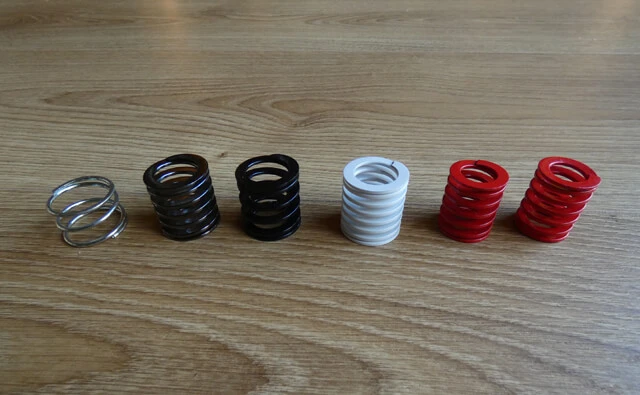
Speaking of customization, you can also adjust the pedals using the 9 different adjustment holes on each one. This allows you to tweak the height, inclination and positioning of your pedals with ease. Adjustability continues into the software you can use to fine-tune things like dead zones and braking force.
Ideal For Beginners
If you’re an absolute beginner, this might all seem a bit complex. However, you don’t need to touch any of these adjustments if you don’t want to, making these an ideal pedal set that works perfectly right out of the box. As they’re a load cell set, you’ll want to ensure you can secure them into your rig, but once you do, you’ll be in for an excellent sim racing experience!
Thrustmaster T-LCM Pedals
Key Specs:
- Compatibility: PC / PlayStation / Xbox
- Mechanism: Load cell brake
- Weight: 5.2 kg / 11.5 lbs
- Custom Software: Thrustmaster Control Panel
PROS:
- Ideal for beginners and intermediate racers
- Load cell for excellent feel
- Good value for money
CONS:
- Quite heavy
- Fair bit of plastic in their construction
MOZA SR-P Pedals
Experience Level: Beginner | Price Point: Low
Who Should Buy These: Absolute beginners on PC that have a very low budget
Next is another entry from MOZA, and this time it’s their cheaper load cell offering in the SR-P pedals. These offer a great sim racing experience for beginners and more advanced racers too, and they’re cheaper than the CSL Elite V2 pedals from Fanatec.
MOZA SR-P Pedals
Great Set Of Pedals
These pedals are aimed at the beginner to intermediate level of sim racers, with the load cell brake pedal offering a decent level of immersion, and the relatively low price point catering to those on a bit of a tighter budget. The pedals don’t suffer much in terms of build quality as a result of being cheaper though, and their all-metal construction reflects that.
They’re made from high-strength steel, which adds a bit of weight, but it ensures they’re built to last, rather than featuring any plastic components. They’re fairly easy to mount to your rig, and they can connect to your PC via USB port, which means you can use these pedals alongside other manufacturers’ equipment.
The 75 kg load cell is impressive at this price point, and it offers plenty of immersion that you can customize from your phone with MOZA’s Pit House app. The brake pedal uses both the load cell and an angle sensor to allow fine-tuning of your braking experience, and while there are more customizable options out there, this strikes a good balance between price and performance.
Why They’re Not As Good As The CSL Elite V2s
The cheaper price point for much of the same immersion level as the CSL Elites might leave you wondering why I wouldn’t rate these higher than I rate the CSL Elites. There are two main reasons for this, with the first being that these pedals are not console compatible. Secondly, you need to pick up an accessory kit separately if you want maximum adjustability.
While this accessory kit isn’t going to break the bank, we’d have liked to see it included here. The kit comes with a few extra springs and damper blocks to give you additional customization over your braking experience. Again, it’s quite cheap, but given it’s not included, and the fact these pedals can’t be used on console, I’d still suggest the CSL Elites over these.
But overall, for the price, you get an excellent set of pedals that would do well as anyone’s first introduction to load cell technology. These would serve as the ideal starting point for someone in the MOZA ecosystem, with the CRP pedals we discussed earlier serving as the natural next step once you improve your racing skills and start wanting more!
MOZA SR-P Pedals
Check PriceKey Specs:
- Compatibility: PC
- Mechanism: Load cell brake
- Weight: 7.5 kg / 16.5 lbs
- Custom Software: Pit House App
PROS:
- Excellent value for money
- Strong 75 kg load cell
- Solid beginner choice
CONS:
- Not console compatible
- You need to buy a separate accessory kit for more adjustability
Simagic P2000 Pedals
Experience Level: Intermediate/Advanced | Price Point: High
Who Should Buy These: Sim racers on PC that want plenty of adjustability and hydraulic feel (with a decent budget)
The Simagic P2000 pedals are some of the coolest looking pedals on the market, and they’re some of the most adjustable too. There are lots of options available, with 100 kg and 200 kg load cell versions (220 and 440 lbs). They are a hydraulic set, so they’re not designed for beginners, but given they’re hydraulics their price isn’t too astronomical.
The video below goes through these pedals in immense detail, so you will definitely be able to gauge if these are a good option for you.
These pedals offer a lot of customization options, and their build quality is up there with the best. They also look great (at least in my opinion), and they’re very unique in what is becoming quite a crowded pedal market. Overall, they’re going to be beyond what beginners and many experienced racers will ever need, but they’re definitely worth checking out.
Key Specs:
- Compatibility: PC
- Mechanism: Hydraulic brake + hydraulic dampers and load cells on throttle and clutch
- Weight: 6.1 kg / 13.4 lbs
- Custom Software: SimPro Manager
PROS:
- Hydraulic mechanisms for realistic feel
- Load cells on each pedal for more accuracy
- Great looking set of pedals
CONS:
- A bit on the pricey side
- Hydraulics may be beyond most racers’ needs
Meca Evo1 Pedals
Experience Level: Intermediate | Price Point: Medium
Who Should Buy These: Fairly experienced sim racers that want a very durable set of pedals that’s highly adjustable in the software department
The Meca EVO1 pedals are another exciting looking product that just oozes quality. They’re made from 4 mm thick steel, with the build quality present on the exterior and in the electronics that make these pedals work. They use a load cell brake, and along with adjusting how the pedal behaves, you can also adjust the facings and positions to suit your preferences.
Meca Evo1 Pedals
Ideal For F1 & GT Racing
There’s also a load cell on the throttle pedal for improved accuracy, and overall these pedals are a great choice for PC racers that play a lot of GT and F1 racing games. There is a hydraulic version of these pedals, but the load cell variant is going to be adequate for most racers.
They have a nice aesthetic, and that good look is paired with excellent build quality thanks to the 4 mm thick steel construction I mentioned above. They also feature pre-drilled holes for easy mounting to your rig, and the range of adjustability will be up to the standards most sim racers need.
You can also adjust a lot of the pedals’ behavior through the included Meca Control Panel software, tweaking 9 different point curve settings. They come in at a reasonable price point, probably just outside what beginners will shoot for, but they’re definitely worth considering as an upgrade over your first set of pedals if you’re on PC.
Key Specs:
- Compatibility: PC
- Mechanism: Load cells on all 3 pedals
- Weight: 6 kg / 13.2 lbs
- Custom Software: Meca Control Panel
PROS:
- Reasonably priced
- Very durable
- Heavy-duty load cell brake
CONS:
- No pedal plate included
ImSim Talento Pedals
Experience Level: Intermediate/Advanced | Price Point: High
Who Should Buy These: Sim racers with a decent budget that want a simple aesthetic and a strong load cell
The ImSim Talentos offer a simple racing aesthetic, but the real magic is in the performance of these pedals. You get a 160 kg (350 lb) load cell brake pedal that can be adjusted using various elastomers, and the gas and clutch pedal (should you opt for one) also offer a realistic experience that can be tweaked very easily.
ImSim Talento Pedals
Very Well Made
These pedals are made from laser cut stainless steel, which is a pretty common theme on this list, but it’s a sure-fire mark of quality where pedals are concerned. They’re designed to be easily mounted into most setups, and you can even mount them upright or inverted to suit your preferred driving style.
You get load cells on all three pedals, which while not totally necessary does make for improved accuracy on all of your inputs. They’re also highly adjustable as is to be expected at this price point, and you can also use the ImSim software to create, store and share your profiles. This makes swapping between setups for different games, cars and tracks an absolute breeze.
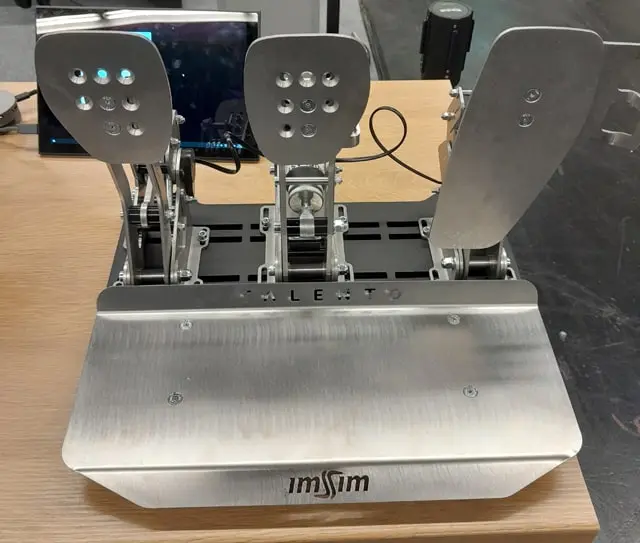
The pedals have smooth faces, with the aim being to make them suitable even for sim racers that prefer to drive in socks. While these aren’t the flashiest pedals on the sim racing market, they are worth checking out if you’re looking for an adjustable, high-quality load cell set.
Key Specs:
- Compatibility: PC
- Mechanism: Load cell brake
- Weight: N/A
- Custom Software: ImSim
PROS:
- Very durable design
- Highly adjustable
- Nice ImSim software
CONS:
- Aesthetic won’t be to everyone’s tastes
- They are quite pricey
Venym Atrax Pedals
Experience Level: Intermediate/Advanced | Price Point: High
Who Should Buy These: Anyone looking for a customizable and highly adjustable (but also pricey) set of pedals
Venym are a fairly new entrant in the world of sim racing, but their Atrax pedals are getting a lot of attention. Endorsed by Former F1 driver and current IndyCar driver Romain Grosjean, these pedals look amazing. They’re available in a wide array of colors, and their sheer build quality and performance is truly impressive for their price point.
These aren’t cheap by any means, but if you’re in the market for a set of high performing load cell sim racing pedals, they’re definitely an option to consider. See the video above for a whistle-stop tour of why they’re so exciting!
Incredible Performance
They feature load cells on all three pedals (something that’s becoming more common in the premium pedal market), with the important one on the brake being 200 kg (440 lbs). You can tweak the feel of this using various different rubbers included in the box. There are also various springs and other kits you can tag on – but they’ll obviously increase the price too.
Note: There’s a great looking carbon option available, but I have to point out that they will flex a lot more than the standard versions. They’re still high-quality as is to be expected, but the flex may be noticeable and is worth considering if you’re thinking of going for the carbon look.
These pedals are likely going to be best for more experienced drivers, and even professionals will find them to be more than adequate. I recently spoke to Team Fordzilla driver Will Chadwick and he told me he loves them, so these definitely have the backing of some of the top drivers. However, for a similar experience at a slightly lower price point, I’d probably recommend the Heusinkveld Sprints.
Key Specs:
- Compatibility: PC
- Mechanism: Load cells on all 3 pedals
- Weight: N/A
- Custom Software: Pitstop
PROS:
- Lots of options to choose from
- Highly customizable feel
- Excellent performance
CONS:
- Quite a pricey option
Simtag Hydraulic Pedals
Experience Level: Advanced/Pro | Price Point: Very High (emphasis on the very!)
Who Should Buy These: Pro and competitive sim racers that need a set of hydraulic pedals
If you’re in the market for a set of hydraulic pedals, this option from Simtag is worth checking out. They’re tough to get your hands on, but they are some of the most well-built (and expensive) pedals on the market. They feature a modified Tilton 600 Series assembly, so they’re built to last and perform at the highest level.
Simtag Hydraulic Pedals
Very Advanced Set Of Pedals
They’re fully hydraulic, meaning they’re beyond what most sim racers will ever need, and they do require a bit of maintenance. However, they’re still one of the best hydraulic pedal sets around. If you want some of the most realistic feel (and a pretty badass looking set of pedals), these are definitely worth considering.
However, for anyone on a budget or not interested in hydraulics (and personally I don’t think you need to be), these are going to be far more than you’ll ever need. They’re incredibly well made, feature lots of adjustability and are designed to be the best of the best, but honestly, no matter your experience level, there are better, cheaper options out there (like the Heusinkveld Ultimate+ pedals).
Key Specs:
- Compatibility: PC
- Mechanism: Hydraulic
- Weight: N/A
- Custom Software: N/A
PROS:
- Incredibly realistic feel
- Superior build quality
- Lots of adjustability
CONS:
- Extremely expensive
- Beyond what most sim racers need
Simucube Active Pedals
Experience Level: Advanced/Pro | Price Point: Very High (take the cost of the 3-pedal Simtag set above and that’s about how much you’re paying for one of these pedals)
Who Should Buy These: Those with money to burn that want the absolute best on the market!
Finally, we have the Simucube Active Pedals. These are arguably the most exciting development in the sim racing space, as they are a force feedback pedal set – well, actually you buy the pedals individually, so ‘set’ isn’t the right word. You can buy an individual pedal and use it as a brake, gas or even a clutch pedal.
Simucube Active Pedal
Incredibly Expensive
But at the high price point, you’re unlikely to be getting more than one of these at a time! They aim to provide the most immersive racing experience on the market thanks to their unique ABS and traction control-replicating force feedback, and so these are really only for the most dedicated sim racers with the biggest budgets!
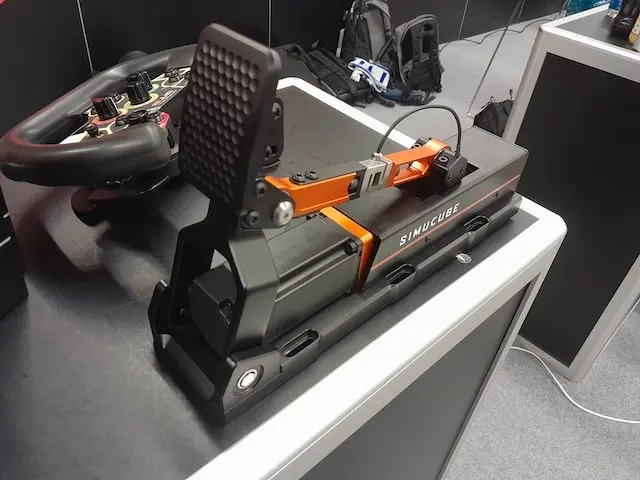
While you need force feedback in your sim racing wheel to feel immersed, you don’t typically think about it at your feet. But Simucube have created something truly impressive here, bringing to market a pedal capable of telling you when ABS is kicking in, or when your wheels are slipping, far better than any vibration motors (see the ClubSport V3s) or rumble in your wheel base ever will.
The pedals are also incredibly well built (as you would expect from Simucube), made from CNC machined metal. They’re designed to be “the last pedal you’ll ever need” and it’s clear that’s the case. However, their high price ($2,000+ per pedal) means they’re well out of reach of most sim racers, but they are definitely up there with the best!
Key Specs:
- Compatibility: PC
- Mechanism: Load cell + force feedback
- Weight: 6 kg / 13.2 lbs (per pedal)
- Custom Software: True Drive
PROS:
- Unbelievably realistic
- Superb build quality
- Very highly adjustable
CONS:
- Extremely expensive
- Way beyond the needs of most sim racers
Summary Of The Best Sim Racing Pedals
| Pedals | Notes |
| Heusinkveld Ultimate Pedals | Incredible build quality Immersive feel thanks to hydraulic damping Very expensive |
| Fanatec Clubsport V3 Pedals | Console compatible pedals Vibration functionality for extra immersion Some sensor issues after many years of use |
| Simtrecs ProPedal GT | Excellent construction Huge amount of adjustability Can be hard to find, and they’re a bit pricey |
| Heusinkveld Sim Pedals Sprint | Great middle ground option Load cells on all three pedals More expensive alternative to the Fanatec V3s |
| Simworx Pro GT V3.1 Pedals | Very advanced set of sim racing pedals Super construction that’s built to last Expensive and beyond what most will need |
| Asetek Invicta Pedals | Very immersive hydraulic brake They look fantastic The very stiff brake can be tough to get used to |
| MOZA CRP Pedals | A good (but more expensive) Fanatec V3 competitor But they won’t work on console Unique 3-stage clutch |
| Fanatec CSL Elite V2 Pedals | Simple but brilliant design Good entry-level load cell pedals Not the most adjustable |
| Logitech Pro Pedals | Great upgrade from the G29/G920/G923 pedals Very beginner friendly A bit overpriced for what you get |
| Thrustmaster T-LCM Pedals | Ideal choice for beginners/console racers Decent amount of adjustability Quite heavy considering there’s some plastic in there |
| MOZA SR-P Pedals | Brilliant value for money Great for beginners Not console compatible |
| Simagic P2000 Pedals | Ideal for intermediate to advanced racers Quite expensive but good value Highly adjustable pedal set |
| Meca Evo1 Pedals | A good mid-tier option Very high build quality Accurate throttle thanks to a load cell |
| ImSim Talento Pedals | Super strong load cell brake Pretty basic aesthetic Durable construction |
| Venym Atrax Pedals | Highly customizable set of pedals Unique design On the expensive side |
| Simtag Hydraulic Pedals | Highly advanced set of pedals Excellent hydraulic mechanism Very expensive and beyond what most racers need |
| Simucube Active Pedals | Incredible force feedback effects Superb Simucube build quality Extremely expensive |
How To Choose A Sim Racing Pedal Set
Choosing between the pedals on our list above is not always going to be easy. Many of the options are very similar in features and price, so a lot of it will come down to personal preference. But below I’ll go through some of the key things to look for when choosing a sim racing pedal set to make sure you can get the right ones for your specific setup. But why should you take the time to go through this?
One Of The Most Important Upgrades
Your pedals are often touted as the most important part of your rig, and whether that’s true or not for you specifically, they are definitely one of the key components. They’re what allow you to control the car into, through, and out of the corners, and that’s where you make up the most time on track. Your steering inputs matter too of course, but pedal inputs are where the extra tenths are really made up.
Most good-quality sim racing pedals do a decent job of emulating how it feels to drive a real race car, but some obviously do it better than others. But just because the Simucube Active Pedal can replicate ABS and traction control, it does not mean you won’t be as good a sim racer without them!
A more expensive pedal set will not instantly make you a faster driver!
So, consider what you really want and actually need from sim racing pedals before you make your choice. Not only will you be better able to choose between the sea of options out there, but you’ll also likely save money by avoiding either:
- Buying a lower quality set and needing to upgrade sooner (at a higher total cost)
- Spending too much and struggling to get the most out of a pedal set that’s too advanced (wasting money)
So, what else do you need to consider when choosing a set of sim racing pedals?
Potentiometer vs Hall Effect vs Load Cell vs Hydraulic
Potentiometer
As a beginner, you might be familiar with potentiometer pedals, which use mechanical sensors to measure pedal travel distance. These are most commonly found on the likes of the pedals that come with the Logitech G29/G920 wheels.
Hall Effect Sensor
These are now largely being replaced by Hall effect sensors, which are more reliable than potentiometers as they work using a contactless system. These are fine for the gas and clutch, as while you want a load cell on the brake (see below), you don’t typically need it on the other pedals.
Note: All of the options on our list use either a load cell or a hydraulic brake, but many of them feature Hall effect sensors on the gas and clutch pedals.
Load Cell
The best option for the brake pedal for most sim racers is the load cell. These measure pressure – how hard you press the pedal – rather than travel distance – how far you press it. Not only are load cells more reliable than potentiometers as well, but they’re also far more accurate and better replicate how it feels to brake in a real car, boosting the immersion factor.
Hydraulics
Lastly, you have hydraulic pedals, which use hydraulic fluid to measure braking force. Some pedals are fully hydraulic, while others just feature hydraulic dampers to offer better feel without affecting the sensor input. These are the most expensive, and definitely not a must-have – especially for beginners!
As a summary:
- Potentiometers, while now rare on new pedals, are the most basic pedal mechanism
- Hall effect sensors are a step up, but they’re still not that immersive (but they’re fine for the gas and clutch)
- Load cells are the ideal choice for most sim racers, balancing price, ease of use, and performance
- Fully hydraulic pedals are above what most racers need, but hydraulic damping can boost immersion
Your Budget
If you like to race competitively, you’ll need to be comfortable with spending a bit more cash. And if you’re a more casual enthusiast, you should probably consider cheaper pedal sets without compromising on features and longevity. If you want to see the cheapest options on this list, check out the Thrustmaster T-LCMs or the MOZA SR-P pedals.
Compatibility
Aside from budget, there’s another very practical factor to think about before committing to a particular pedal set. You need to consider what gear you already have and whether it will be compatible with the pedal set of your dreams!
PC gamers will be able to mix and match their sim racing gear to make a rig, so it isn’t as crucial for them to think about. But for console gamers, a Thrustmaster pedal set will only work with Thrustmaster racing wheels, and Fanatec pedals will only work with Fanatec racing wheels. Many pedal sets simply aren’t compatible with consoles at all, so bear that in mind when browsing for your next set.
The best pedals for console racers are the Fanatec ClubSport V3s (or the CSL Elite V2s if you’re on a tighter budget), although the T-LCMs from Thrustmaster are also a good choice.

The Features
You should also be looking at what’s offered in terms of features when browsing for pedals. This includes things like brake technology, extra features like rumble for ABS and traction control, and adjustability. One of the most unique pedal sets on the market is the ClubSport V3 set from Fanatec, which features vibration motors on the gas and brake pedals.
Build Quality
The materials they’re built from and the overall build quality are also very important to consider. Plastic just won’t cut it when looking for realism and longevity, as it’ll feel too flimsy and generally won’t last as long as metal will. The best materials for pedal sets are metal-based, even the lightweight kinds, because it feels closer to a real car.
Some of the best build quality can be seen in Heusinkveld’s Sprint and Ultimate+ pedals.
Stability
Another key feature to look for is stability. The last thing you want is a pedal set that shoots out from under you in heavy braking zones. A large part of a set’s stability comes from the materials used to build it, and of course heavier sets made of metal will help with this aspect a lot. Always opt for pedals that can be hard mounted to your rig.
Note: All of the pedals on our list can be hard mounted to your rig, but not all come with a baseplate – make sure to check for this when buying if that’s something you need.
Adjustability
The overall adjustability of the pedals will also be important, as you want to be able to set them up in the optimal configuration for your own driving style. Everything from the pedal positions to the way they respond can often be tuned using software or even physically on the pedals themselves, and the more customization you can have the better.
Other small things you might want to consider is the pedal arrangement, such as if they are inverted or not (like the Fanatec ClubSport V3s). You obviously might also want to consider how many pedals you need, as there are lots of single and double pedal options on the market, and you don’t need to simply go for the full 3-pedal setup. However, the three pedal setup is by far the most versatile, but also the mot expensive.
KEY POINTS
• Always opt for the best set of pedals you can afford
• Choose a set that’s durable and stable
• Adjustability and other unique features will also come into play
• A more expensive pedal set won’t instantly make you faster!
Final Thoughts
There’s a lot to think about when choosing your next sim racing pedal set, but the main things to focus on are build quality, the level of immersion offered, and compatibility with the rest of your rig. If you want the very best option, then you should opt for the Heusinkveld Sprint pedals, but the Thrustmaster T-LCM pedals are a good choice for beginner and intermediate racers.
I created and have been writing on this site since 2019, collaborating with drivers, coaches, engineers and manufacturers to provide you with the most reliable information about motorsport. I also make beautiful car posters and track posters.

